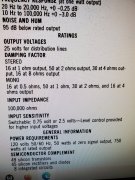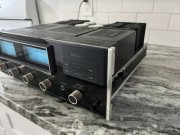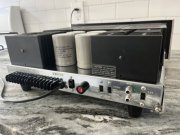You are using an out of date browser. It may not display this or other websites correctly.
You should upgrade or use an alternative browser.
You should upgrade or use an alternative browser.
So I Did It ! My First Mcintosh MC2125
- Thread starter Greg
- Start date
VSAT88
Veteran and General Yakker
Let me know what you think about the sound.
krellmk
Chief Journeyman
- Joined
- Nov 3, 2016
- Messages
- 741
- Location
- Brooklyn NY
- Tagline
- Are you satisfied with the life you're living
I had 2 MAC arrive with broken glass face these not cheap to buy from MAC
VSAT88
Veteran and General Yakker
Naw I would bet not. Should they not be removed for shipping? I bought mine local. At 85 lbs. I would not want to know I had to ship it.
- Joined
- Jan 14, 2011
- Messages
- 75,900
- Location
- Gillette, Wyo.
- Tagline
- Halfbiass...Electron Herder and Backass Woof
Transformer coupled outputs..
Not good
Not good
VSAT88
Veteran and General Yakker
That's why I bought mine. Wanted to hear what all the fuss was about with the autoformer/transformer outputs Lee. So far I am not overly impressed. I will have to say that I have not given the amplifier any real listening time nor have I taken it down to check all the components.
Quote from over at the evil A.K.
"
The McIntosh Autoformer
Transistor power output circuits can match 8-ohm loads directly. This eliminates the need for the output transformer for most manufacturers. However, output stages that are designed to operate into an optimum load of 8 ohms can double or quadruple heat dissipation when operating into 4 or 2 ohm loads. At some frequencies, speakers rated at 8 ohms can dip as low as 4 ohms. Some 4-ohm systems can dip even lower. This mismatch can cause the amplifier to exceed its thermal dissipation limits.
On the other hand, if an amplifier is designed for an optimum load of one or two ohms, a low impedance load would be no problem. However, less power would be available for a speaker having 4 or 8 ohms impedance.
The unique McIntosh output autoformer was the answer. Since McIntosh output stages were connected in a single ended push-pull circuit, one side of the output was always connected to ground. They were typically designed to work into an optimum load of 2.1 ohms. The matching autoformer was connected directly to the output. In the MC2505 amplifier, the matching output was for 4, 8 and 16 ohms. Other impedances became available in later amplifiers. Full continuous amplifier power could be delivered to each of these loads. There qas no danger of exceeding safe limits or overheating.
The autoformer also protected the speakers from damage in the event of amplifier failure. Should a direct current component appear at the amplifier output, it was shunted by the low DC resistance of the autoformer, instead of passing through the speaker voice coil, which could damage the speaker or even cause a fire.
McIntosh autoformers continued to be used in the "top-of-the-line" amplifiers. They were all designed and manufactured by McIntosh. Although the autoformers added extra cost, weight and took up extra space, they assured a safe, optimum match to a variety of speakers and speaker hook-ups. They were constructed and performed in the McIntosh tradition of excellence. "
We will see right?
Quote from over at the evil A.K.
"
The McIntosh Autoformer
Transistor power output circuits can match 8-ohm loads directly. This eliminates the need for the output transformer for most manufacturers. However, output stages that are designed to operate into an optimum load of 8 ohms can double or quadruple heat dissipation when operating into 4 or 2 ohm loads. At some frequencies, speakers rated at 8 ohms can dip as low as 4 ohms. Some 4-ohm systems can dip even lower. This mismatch can cause the amplifier to exceed its thermal dissipation limits.
On the other hand, if an amplifier is designed for an optimum load of one or two ohms, a low impedance load would be no problem. However, less power would be available for a speaker having 4 or 8 ohms impedance.
The unique McIntosh output autoformer was the answer. Since McIntosh output stages were connected in a single ended push-pull circuit, one side of the output was always connected to ground. They were typically designed to work into an optimum load of 2.1 ohms. The matching autoformer was connected directly to the output. In the MC2505 amplifier, the matching output was for 4, 8 and 16 ohms. Other impedances became available in later amplifiers. Full continuous amplifier power could be delivered to each of these loads. There qas no danger of exceeding safe limits or overheating.
The autoformer also protected the speakers from damage in the event of amplifier failure. Should a direct current component appear at the amplifier output, it was shunted by the low DC resistance of the autoformer, instead of passing through the speaker voice coil, which could damage the speaker or even cause a fire.
McIntosh autoformers continued to be used in the "top-of-the-line" amplifiers. They were all designed and manufactured by McIntosh. Although the autoformers added extra cost, weight and took up extra space, they assured a safe, optimum match to a variety of speakers and speaker hook-ups. They were constructed and performed in the McIntosh tradition of excellence. "
We will see right?
gene french
Veteran and General Yakker
- Joined
- Mar 6, 2022
- Messages
- 5,888
- Tagline
- music...the healer of souls...
i would like to hear one too....That's why I bought mine. Wanted to hear what all the fuss was about with the autoformer/transformer outputs Lee. So far I am not overly impressed. I will have to say that I have not given the amplifier any real listening time nor have I taken it down to check all the components.
Quote from over at the evil A.K.
"
The McIntosh Autoformer
Transistor power output circuits can match 8-ohm loads directly. This eliminates the need for the output transformer for most manufacturers. However, output stages that are designed to operate into an optimum load of 8 ohms can double or quadruple heat dissipation when operating into 4 or 2 ohm loads. At some frequencies, speakers rated at 8 ohms can dip as low as 4 ohms. Some 4-ohm systems can dip even lower. This mismatch can cause the amplifier to exceed its thermal dissipation limits.
On the other hand, if an amplifier is designed for an optimum load of one or two ohms, a low impedance load would be no problem. However, less power would be available for a speaker having 4 or 8 ohms impedance.
The unique McIntosh output autoformer was the answer. Since McIntosh output stages were connected in a single ended push-pull circuit, one side of the output was always connected to ground. They were typically designed to work into an optimum load of 2.1 ohms. The matching autoformer was connected directly to the output. In the MC2505 amplifier, the matching output was for 4, 8 and 16 ohms. Other impedances became available in later amplifiers. Full continuous amplifier power could be delivered to each of these loads. There qas no danger of exceeding safe limits or overheating.
The autoformer also protected the speakers from damage in the event of amplifier failure. Should a direct current component appear at the amplifier output, it was shunted by the low DC resistance of the autoformer, instead of passing through the speaker voice coil, which could damage the speaker or even cause a fire.
McIntosh autoformers continued to be used in the "top-of-the-line" amplifiers. They were all designed and manufactured by McIntosh. Although the autoformers added extra cost, weight and took up extra space, they assured a safe, optimum match to a variety of speakers and speaker hook-ups. They were constructed and performed in the McIntosh tradition of excellence. "
We will see right?
krellmk
Chief Journeyman
- Joined
- Nov 3, 2016
- Messages
- 741
- Location
- Brooklyn NY
- Tagline
- Are you satisfied with the life you're living
I have here MAC2505 the reviews say this is the best MAC amplifier has a tubey sound don't think i listen to it 2 session been sitting here for the past 5 years has a shelf fixture with other MAC stuff i got
krellmk
Chief Journeyman
- Joined
- Nov 3, 2016
- Messages
- 741
- Location
- Brooklyn NY
- Tagline
- Are you satisfied with the life you're living
Gene don't waste your time embrace all your PL stuffi would like to hear one too....
- Joined
- Jan 14, 2011
- Messages
- 75,900
- Location
- Gillette, Wyo.
- Tagline
- Halfbiass...Electron Herder and Backass Woof
That's why I bought mine. Wanted to hear what all the fuss was about with the autoformer/transformer outputs Lee. So far I am not overly impressed. I will have to say that I have not given the amplifier any real listening time nor have I taken it down to check all the components.
Quote from over at the evil A.K.
"
The McIntosh Autoformer
Transistor power output circuits can match 8-ohm loads directly. This eliminates the need for the output transformer for most manufacturers. However, output stages that are designed to operate into an optimum load of 8 ohms can double or quadruple heat dissipation when operating into 4 or 2 ohm loads. At some frequencies, speakers rated at 8 ohms can dip as low as 4 ohms. Some 4-ohm systems can dip even lower. This mismatch can cause the amplifier to exceed its thermal dissipation limits.
On the other hand, if an amplifier is designed for an optimum load of one or two ohms, a low impedance load would be no problem. However, less power would be available for a speaker having 4 or 8 ohms impedance.
The unique McIntosh output autoformer was the answer. Since McIntosh output stages were connected in a single ended push-pull circuit, one side of the output was always connected to ground. They were typically designed to work into an optimum load of 2.1 ohms. The matching autoformer was connected directly to the output. In the MC2505 amplifier, the matching output was for 4, 8 and 16 ohms. Other impedances became available in later amplifiers. Full continuous amplifier power could be delivered to each of these loads. There qas no danger of exceeding safe limits or overheating.
The autoformer also protected the speakers from damage in the event of amplifier failure. Should a direct current component appear at the amplifier output, it was shunted by the low DC resistance of the autoformer, instead of passing through the speaker voice coil, which could damage the speaker or even cause a fire.
McIntosh autoformers continued to be used in the "top-of-the-line" amplifiers. They were all designed and manufactured by McIntosh. Although the autoformers added extra cost, weight and took up extra space, they assured a safe, optimum match to a variety of speakers and speaker hook-ups. They were constructed and performed in the McIntosh tradition of excellence. "
We will see right?
Doesn't do much for damping factor. If the intention was to make it safe to drive any speaker, theres going to be a lot of tradeoffs.
Give me damping factor or give me death...
- Joined
- Jan 14, 2011
- Messages
- 75,900
- Location
- Gillette, Wyo.
- Tagline
- Halfbiass...Electron Herder and Backass Woof
Heard some 2105's when Stephen and I were running them against a 400 WOPL ..they sounded like shit next to that WOPL..
krellmk
Chief Journeyman
- Joined
- Nov 3, 2016
- Messages
- 741
- Location
- Brooklyn NY
- Tagline
- Are you satisfied with the life you're living
All landfill candidates
gene french
Veteran and General Yakker
- Joined
- Mar 6, 2022
- Messages
- 5,888
- Tagline
- music...the healer of souls...
of course...i just was curious!!!Gene don't waste your time embrace all your PL stuff
i am happy with the status quo
VSAT88
Veteran and General Yakker
Same one here, 2205. I ain't gonna lie I ain't never heard no McIntosh gear in a home before. I ain't no money man so only wanted one because a lot of folks say they are the shit and they do look pretty bad ass. Well, I finally got the chance to buy on at a pretty good price. Funny you say that about dampening factor Lee. Looks like this amp has none. Is a PL 400 stock not like 1000?

VSAT88
Veteran and General Yakker
Well I got a bud who wants it so bad he can't stand it and he may well get it too. He likes the big meters. I could soon give a rats ass about the meters. They are cool and all but I want what's inside to do the talking.
marcok
Chief Journeyman
No dynamic range ! To be honest I never understood this kind of configurationTransformer coupled outputs..
Not good
with solid state amps .
Ciao
Marco
Vynuladikt
Journeyman
- Joined
- May 4, 2016
- Messages
- 466
- Location
- Northeast Iowa
- Tagline
- Love great audio, beermaking and pyrotechnics
Agree, it makes sense for tubes, due to the voltage a transformer is a natural solution, but not in SS.No dynamic range ! To be honest I never understood this kind of configuration
with solid state amps .
Ciao
Marco
gene french
Veteran and General Yakker
- Joined
- Mar 6, 2022
- Messages
- 5,888
- Tagline
- music...the healer of souls...
love your setup in the picAgree, it makes sense for tubes, due to the voltage a transformer is a natural solution, but not in SS.
- Joined
- Jan 14, 2011
- Messages
- 75,900
- Location
- Gillette, Wyo.
- Tagline
- Halfbiass...Electron Herder and Backass Woof
Same one here, 2205. I ain't gonna lie I ain't never heard no McIntosh gear in a home before. I ain't no money man so only wanted one because a lot of folks say they are the shit and they do look pretty bad ass. Well, I finally got the chance to buy on at a pretty good price. Funny you say that about dampening factor Lee. Looks like this amp has none. Is a PL 400 stock not like 1000?View attachment 70249
Yep...
- Joined
- Jan 14, 2011
- Messages
- 75,900
- Location
- Gillette, Wyo.
- Tagline
- Halfbiass...Electron Herder and Backass Woof
Got a call from Chris in Iowa this weekend. He has the 400 watt per channel Mac.....he was asking oiw much for a WOPL 700....he's heard some here...



